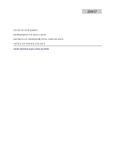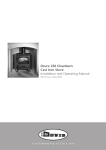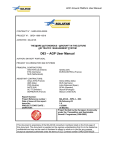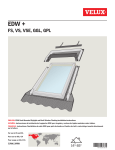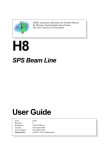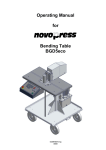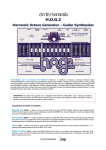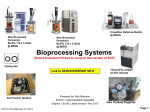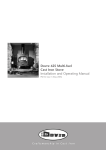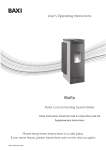Download Baxi Bioflo Operating instructions
Transcript
Installation & Servicing Instructions Bioflo Pellet Central Heating System Boiler These instructions should be read in conjunction with the Supplementary Instructions Please keep these instructions in a safe place. If you move house, please hand them over to the next occupier. © Baxi Heating UK Ltd 2010 Baxi Bioflo 12 kW Granite Baxi Bioflo 12 kW Pearl © Baxi Heating UK Ltd 2010 All rights reserved. No part of this publication may be reproduced or transmitted in any form or by any means, or stored in any retrieval system of any nature (including in any database), in each case whether electronic, mechanical, recording or otherwise, without the prior written permission of the copyright owner, except for permitted fair dealing under Copyrights, Designs and Patents Act 1988. Applications for the copyright owner’s permission to reproduce or make other use of any part of this publication should be made, giving details of the proposed use, to the following address: The Company Secretary, Baxi Heating UK Ltd, Brooks House, Coventry Road, Warwick. CV34 4LL Full acknowledgement of author and source must be given. WARNING: Any person who does any unauthorised act in relation to a copyright work may be liable to criminal prosecution and civil claims for damages. Table of contents: Page Important initial information for the Technician . . . . . . . . . . . . . . . . . . . . . . . . . . . . .4 1.1 Safety . . . . . . . . . . . . . . . . . . . . . . . . . . . . . . . . . . . . . . . . . . . . . . . . . . . . . . . . . . . . . . . . . . . . . . . . . . . . .4 1.2 Please note! . . . . . . . . . . . . . . . . . . . . . . . . . . . . . . . . . . . . . . . . . . . . . . . . . . . . . . . . . . . . . . . . . . . . . . . .4 1.3 Fuel . . . . . . . . . . . . . . . . . . . . . . . . . . . . . . . . . . . . . . . . . . . . . . . . . . . . . . . . . . . . . . . . . . . . . . . . . . . . . . .4 1.4 Fuel storage - Manuell pellet supply . . . . . . . . . . . . . . . . . . . . . . . . . . . . . . . . . . . . . . . . . . . . . . . . . . . . .5 1.5 Application options . . . . . . . . . . . . . . . . . . . . . . . . . . . . . . . . . . . . . . . . . . . . . . . . . . . . . . . . . . . . . . . . . .5 1.6 Flue . . . . . . . . . . . . . . . . . . . . . . . . . . . . . . . . . . . . . . . . . . . . . . . . . . . . . . . . . . . . . . . . . . . . . . . . . . . . . . .5 For the Installer . . . . . . . . . . . . . . . . . . . . . . . . . . . . . . . . . . . . . . . . . . . . . . . . . . . . . . .6 2.1 Delivery, packaging . . . . . . . . . . . . . . . . . . . . . . . . . . . . . . . . . . . . . . . . . . . . . . . . . . . . . . . . . . . . . . . . . .7 2.2 Installation . . . . . . . . . . . . . . . . . . . . . . . . . . . . . . . . . . . . . . . . . . . . . . . . . . . . . . . . . . . . . . . . . . . . . . . . .7 2.3 2.3.1 Installation room . . . . . . . . . . . . . . . . . . . . . . . . . . . . . . . . . . . . . . . . . . . . . . . . . . . . . . . . . . . . . .7 2.3.2 Heat radiation . . . . . . . . . . . . . . . . . . . . . . . . . . . . . . . . . . . . . . . . . . . . . . . . . . . . . . . . . . . . . . . .7 2.3.3 Installation siting . . . . . . . . . . . . . . . . . . . . . . . . . . . . . . . . . . . . . . . . . . . . . . . . . . . . . . . . . . . . . .8 2.3.4 Combustion air . . . . . . . . . . . . . . . . . . . . . . . . . . . . . . . . . . . . . . . . . . . . . . . . . . . . . . . . . . . . . . .9 Dimensional sketches . . . . . . . . . . . . . . . . . . . . . . . . . . . . . . . . . . . . . . . . . . . . . . . . . . . . . . . . . . . . . . .10 2.4 Minimum service clearances for fire protection, cleaning and maintenance . . . . . . . . . . . . . . . . . .12 2.4.1 2.4.2 2.4.3 Masonry feed-throughs for the exhaust pipe . . . . . . . . . . . . . . . . . . . . . . . . . . . . . . . . . . . . .12 Minimum service clearances with flue gas tube connection straight back . . . . . . . . . . . . .13 Minimum service clearances with flue gas tube connection to the left or right side . . . . .14 2.5 System . . . . . . . . . . . . . . . . . . . . . . . . . . . . . . . . . . . . . . . . . . . . . . . . . . . . . . . . . . . . . . . . . . . . . . . . . . .15 2.6 2.5.1 Heating fittings . . . . . . . . . . . . . . . . . . . . . . . . . . . . . . . . . . . . . . . . . . . . . . . . . . . . . . . . . . . . . .15 2.5.2 Heating circuits . . . . . . . . . . . . . . . . . . . . . . . . . . . . . . . . . . . . . . . . . . . . . . . . . . . . . . . . . . . . . .15 2.5.3 Domestic water (hot water tank) . . . . . . . . . . . . . . . . . . . . . . . . . . . . . . . . . . . . . . . . . . . . . . . .15 2.5.4 Return temperature . . . . . . . . . . . . . . . . . . . . . . . . . . . . . . . . . . . . . . . . . . . . . . . . . . . . . . . . . .16 2.5.5 Accumulator tank . . . . . . . . . . . . . . . . . . . . . . . . . . . . . . . . . . . . . . . . . . . . . . . . . . . . . . . . . . . .16 2.5.6 Heating water . . . . . . . . . . . . . . . . . . . . . . . . . . . . . . . . . . . . . . . . . . . . . . . . . . . . . . . . . . . . . . .17 2.5.7 Water-side resistance (pressure loss) . . . . . . . . . . . . . . . . . . . . . . . . . . . . . . . . . . . . . . . . . . .17 Installing the cladding . . . . . . . . . . . . . . . . . . . . . . . . . . . . . . . . . . . . . . . . . . . . . . . . . . . . . . . . . . . . . .18 For the Electrician . . . . . . . . . . . . . . . . . . . . . . . . . . . . . . . . . . . . . . . . . . . . . . . . . . . .21 3.1 Electrical connections . . . . . . . . . . . . . . . . . . . . . . . . . . . . . . . . . . . . . . . . . . . . . . . . . . . . . . . . . . . . . .21 For the Service Technician . . . . . . . . . . . . . . . . . . . . . . . . . . . . . . . . . . . . . . . . . . . . . .23 4.1 Initial start-up and operating instructions . . . . . . . . . . . . . . . . . . . . . . . . . . . . . . . . . . . . . . . . . . . . . .23 4.2 Service and repair work . . . . . . . . . . . . . . . . . . . . . . . . . . . . . . . . . . . . . . . . . . . . . . . . . . . . . . . . . . . . .23 4.3 Technical data for calculating the flue gas system acc. to EN 13384-1 . . . . . . . . . . . . . . . . . . . . . . .24 4.4 Technical data – General . . . . . . . . . . . . . . . . . . . . . . . . . . . . . . . . . . . . . . . . . . . . . . . . . . . . . . . . . . . . .24 4.5 Service level . . . . . . . . . . . . . . . . . . . . . . . . . . . . . . . . . . . . . . . . . . . . . . . . . . . . . . . . . . . . . . . . . . . . . . .25 4.5.1 4.5.2 4.5.3 4.6 Parameters . . . . . . . . . . . . . . . . . . . . . . . . . . . . . . . . . . . . . . . . . . . . . . . . . . . . . . . . . . . . . . . . .27 Start-up . . . . . . . . . . . . . . . . . . . . . . . . . . . . . . . . . . . . . . . . . . . . . . . . . . . . . . . . . . . . . . . . . . . .30 Actuator test . . . . . . . . . . . . . . . . . . . . . . . . . . . . . . . . . . . . . . . . . . . . . . . . . . . . . . . . . . . . . . . .30 BAXI Bioflo basic circuitry . . . . . . . . . . . . . . . . . . . . . . . . . . . . . . . . . . . . . . . . . . . . . . . . . . . . . . . . . . .31 “Please read the supplementary assembly instruction document also supplied for clear UK requirements” 3 Important initial information for the Technician 1.1 Safety The boiler and related accessories reflect the state of the art and meet all applicable safety regulations. 1.2 Please note! Your boiler and all accessories operate using 230 VAC electrical current. Improper installation or repair can pose the danger of life-threatening electrical shock. (Building reg Part P.) Caution symbols Please take careful note of the following symbols in these Installation instructions. Ignoring the identified warnings can lead to personal injury. Ignoring the identified warnings can lead to malfunction of, or damage to the boiler or heating system. The specified safety requirements are to be followed in accordance with nationally applicable regulations, standards and guidelines. 1.3 Fuel The boilers are designed to burn the following fuels: Pellets according to ÖNORM M7135 or DINplus. Significant criteria based on the standards are as follows: Diameter 6 mm Smooth surface Residual moisture content max. 10% Ash content max. 0.5% Length 80% between 15 – 30 mm Density at least 1.1 kg/dm3 Energy content min. 18 MJ/kg = 5 kWh/kg (in water-free condition) Abraded particles max. 2.3% Chemical/synthetic binding agents are strictly prohibited No impurities from varnish or paint residues, etc. 4 Important initial information for the Technician 1.4 Fuel storage - Manual pellet supply Pellets in bags must be stored in a dry place. Please observe the local regulations on storing fuel. The pellets must be transported carefully into and out of the storage room so as to maintain good pellet quality. 1.5 Application options BAXI Bioflo is designed for installation in the living area and is configured as a fully featured central heating system. This means no second heat generator is required. If desired, however, BAXI Bioflo can be combined with alternative heat generators (e.g. solar or solid fuel boiler). Refer to the hydraulic systems for details about this. The necessary hydraulic components for a heating circuit as well as hot water preparation are integrated in BAXI Bioflo (see hydraulic equipment). This means there is no longer any need for a boiler room or equipment room and that BAXI Bioflo is ideally suited for use as a central heating system in houses without a basement or when central heating is being installed in a building for the first time as part of a renovation project. 1.6 Flue A properly dimensioned flue is required for optimal functioning of the combustion system. Measurement of the dimensions must follow EN 13384-1. See the Technical data section for values required for this calculation. Please note that in the lower performance range, flue gases may be below 90 °C. Therefore, thermally-insulated flues meeting thermal transmittance coefficient Group I requirements according to DIN 18160 T1 or other appropriate, officially approved moisture-resistant exhaust systems may be connected to the hearths. Frequently, these requirements on the flue are not satisfied during the renovation of existing systems. We therefore suggest an evaluation by the local building inspector before installing the boiler system. In this way appropriate modifications can be made to the flue before system installation. (See the technical data for flue calculation values.) Energy-saving intake regulators or explosion flaps are not allowed to be installed in the living area. Comply with the statutory regulations and directives. 5 For the Installer 2.1 Delivery, packaging Hydraulic equipment type/order no. with circulation pump, expansion tank 12 l, safety valve and pressure gauge BAXI 2.1.1 BAXI Bioflo The boiler is supplied on a wooden pallet covered with a plastic sack. The cladding parts are in a separate cardboard box. Cleaning tools are packed in the combustion chamber and the ash pan. BAXI Bioflo is delivered without cladding (door, cover, side panels) on a pallet, without wood partitions. The cladding parts are in a separate cardboard box. The taking-in weight is less than 200 kg, the taking-in width is 55 cm. 2.1.2 Supplied accessories – Heat shield patented cover for the front window to reduce heat radiation during summer operation – Adapter for external combustion air supply already integrated in the boiler if ordered; connection for plastic pipes Ø 75 mm. – Flue conection adapter 6 For the Installer 2.2 Installation 2.2.1 Installation room Basically, any room with normal air humidity and living space temperature in the living area is suitable for installation, providing it has a flue connection with an adequate draught (see technical data for flue requirements) and satisfies the statutory regulations and directives. Note: Due to the operating and flame noises, we do not recommend installing the device in bedrooms or quiet rooms. BAXI Bioflo is not allowed to be installed in rooms that are very dusty or humid (e.g. bathrooms, sanitary rooms, etc.). The combustion air must be free from halogens and hydrocarbons (detergents, e.g. chlorine, ammonia, fluorine, etc.) otherwise malfunctions may occur. The installation room should not be too small otherwise the room could be overheated by the heat radiation. The recommended rule of thumb is: The installation room should account for at least 15% of the area to be heated. The boiler must be installed in dry, frost-free premises! Limits (maximum): Air humidity: 85% at 25° room temperature (noncondensing) Room temperature +2 to 40°C 2.2.2 Heat radiation The viewing panel of the BAXI Bioflo means it is inevitable that heat will be radiated into the installation room. The distribution of heat between air and water heating is approx. 15 : 85 % without the heat shield and approx. 9 : 91 % with the heat shield (. The following should be noted: – Heating domestic water in summer: Heat radiation always heats up the installation room when domestic water is being heated. Although the amount of radiated heat can be significantly reduced by using the supplied atented heat shield, it can never be totally prevented. This means it may not be possible to rule out overheating the installation room on hot days and, above all, during the summer months. To remedy this, we recommend heating domestic water using an alternative system such as solar or immersion heater supplementation with indirect cylinder.. – Heating surfaces/radiators in the installation room: The heat radiation from BAXI Bioflo has been reduced to the minimum necessary, therefore a corresponding heating surface or radiator should also be installed in the installation room. Heating surfaces in the installation room are essential when the system is combined with alternative heat generators (solar, accumulator tank or solid fuel boiler) – Fig. 2. We recommend using thermostat heads in the installation room. – Minimum room size: BAXI Bioflo very rapidly provides the necessary amount of heat at very low building heat demands or in autumn/spring. Despite the fact that the boiler quickly reduces its output to the minimum level or actually switches itself off entirely, there will nevertheless be a corresponding amount of heat radiation into the installation room. This means it may not be possible to rule out overheating the installation room on hot days and, above all, during the autumn/spring. As a remedy, we recommend having an installation room with a minimum size of approx. 15 % of the entire area to be heated) – Fig. 2. 7 For the Installer Fig. 2 BAXI Bioflo in an installation room (more than approx. 15 % of the entire area to be heated) 2.2.3 Installation siting – The minimum service clearances from flammable materials and for connections, cleaning and maintenance must be complied with building regualtions part J for full guidance –– BAXI Bioflo must be placed directly on hearth contstruction - compliant with Part J. The configuration of the entire system must comply with technical fire protection requirements in accordance with the applicable regulations, standards and guidelines Wall hinges - fireguard minimum requirments of part J for fire protection safety. 8 For the Installer 2.2.4 Combustion air An adequate supply of combustion air is absolutely essential. The following combustion air flow is required for operation at max. heat output: BAXI Bioflo 120 (12 kW): approx. 26 m3/h There are various possible ways of supplying the combustion air: a) Operating with room air (Combustion air supply from the installation room or adjacent room) b) Operating independently of the room air (Combustion air supply from ventilation draught in the chimney) Note: There may be an induction noise from the air supply induction point (air opening in the device), depending on the modulation. The noise can be transferred outside or into an adjacent room by relocating the air supply induction point. Negative pressures in the installation/induction room with point a) Operating with room air are not permitted. The function and safety of BAXI Bioflo is affected when combining with room ventilation systems and combustion air supply from the installation room or adjacent room. Room ventilation systems must switch off automatically when the negative pressure in the device is more than 4 Pa below the external pressure. Special ventilation systems are available for controlled living area ventilation in combination with solid fuel systems – refer to information provided by the manufacturers of ventilation systems. If ventilation systems (e.g. extractor hoods or pneumatic pumping systems, etc.), we recommend routing the combustion air according to point b) Operating independently of the room air. This means it is possible to decouple the combustion air from the air conditions in the installation room to a large extent. In addition, the device is equipped as standard with a pressure monitoring device in the fire box in order to guarantee safe operation of the device. a) Operating with room air: (Combustion air supply from the installation room or adjacent room) Always ensure there is a sufficient combustion air supply (no windows and doors that provide a complete air seal). Combustion air supply from a well ventilated adjacent room via an air intake pipe. The combustion air is carried along an air intake pipe from a well ventilated adjacent room (e.g. stairwell) to the BAXI Bioflo. This avoids the induction noise in the installation room during operation. The air supply is carried in commercially available plastic pipes 1) Ø 75 mm. The maximum induction length is 9 m, each 90° bend1) reduces the length by 1 m. Combustion air supply directly from the installation room: The combustion air is drawn directly by the device from the installation room, therefore the installation room has to be adequately ventilated. Malfunctions or complaints occasioned by inadequate combustion air will not be covered by the guarantee! b) Operating independently of the room air: (Combustion air supply from ventilation draught in the chimney) This variant is to be preferred over operating with room air, because it ensures that there will always be sufficient combustion air and that the induction noise during operation will be transferred to the outside. The air supply is carried in commercially available plastic pipes of diameter 75 mm. The maximum induction length is 9 m, each 90° bend reduces the length by 1 m. 9 For the Installer 2.3 Dimensional sketches 2.3.1 BAXI Bioflo flue gas and air supply connection All dimensions in mm: Side view Front view A.........Flue gases Z .........Air intake Fig. 5 BAXI Bioflo flue gas and air supply connection Standard: Accessories – for exhaust pipe connection in the middle: 1 . . . . .Double exhaust pipe bend rigid 2 . . . . .Pipe clamp Fig. 6 BAXI Bioflo flue gas connection – standard Fig. 7 10 BAXI Bioflo flue gas connection with accessories For the Installer 2.3.2 BAXI Bioflo with circulation pump, expansion tank 12 l, safety valve and pressure gauge Front view Side view All dimensions in mm: HV HV HR HV.......Heating feed (3/4” pipe) HR.......Heating return (3/4” pipe) Fig. 8 BAXI Bioflo with hydraulic fittings fittings 11 For the Installer 2.4 Minimum service clearances for fire protection, cleaning and maintenance The following minimum service clearances from flammable materials and for connections, cleaning and maintenance must be complied with. The configuration of the entire system must comply with technical fire protection requirements in accordance with the applicable regulations, standards and guidelines. 2.4.1 Masonry feed-throughs for the exhaust pipe Examples of masonry feed-throughs tested by the IBS – Institut für Brandschutztechnik und Sicherheitsforschung (Institute for Fire Protection Technology and Safety Research) Multi-layer flammable wall Fig. 9 Multi-layer flammable wall Tested masonry feed-throughs for exhaust pipe Multi-layer flammable wall There must be a gap of 200 mm from flammable components all round the exhaust pipe. 12 Non-flammable wall For the Installer 2.4.2 Minimum service clearances with flue gas tube connection straight back Dimension Clearance Description a 800 mm Minimum clearance in radiation area (front window) from flammable materials b 500 mm Minimum lateral clearance from non-movable objects (e.g. wall) c 50 mm Minimum lateral clearance from movable objects (e.g. furniture) 400 mm Minimum clearance from flammable walls with non-insulated exhaust pipe Minimum clearance from flammable walls with insulated exhaust pipe (20 mm) f 200 mm 1) Minimum clearance from flammable walls with tested double-walled insulated exhaust pipe, acc. to accreditation of connecting piece 2) 1) Note: The intake air line must be non-flammable (e.g. flexible aluminium tube) if the exhaust pipe is uninsulated. If the walls are non-flammable, there are no fire protection reasons for a minimum service clearance from the exhaust pipe and no need to insulate the exhaust pipe. Fig. 9 BAXI Bioflo – view from above 1) Technical data for exhaust pipe insulation: Mineral wall insulation; melting point: >1000 °C; thermal conductivity: < 0.04 W/mK 2) The minimum service clearance is determined by the design specifications (Ø of the double pipe) of the flue gas system used or the minimum service clearances demanded in the accreditation. 13 For the Installer 2.4.3 Minimum service clearances with flue gas tube connection to the left or right side Dimension Clearance a 800 mm Minimum clearance in radiation area (front window) from flammable materials b 500 mm Minimum lateral clearance from non-movable objects (e.g. wall) c 50 mm Minimum lateral clearance from movable objects (e.g. furniture) d1) f Description >500 mm Minimum clearance from flammable walls with non-insulated exhaust pipe >305 mm Minimum clearance from flammable walls with insulated exhaust pipe (20 mm) >210 mm 2) >250 mm 2) 1) Minimum service clearance from flammable walls, flue connection to left or right and tested double-walled insulated exhaust pipe 2) >140 mm Minimum service clearance from non-flammable walls, flue connection to left or right 400 mm Minimum clearance from flammable walls with non-insulated exhaust pipe 200 mm Minimum clearance from flammable walls with insulated exhaust pipe (20 mm) >50–70 mm 3) 1) Minimum clearance from flammable walls with tested double-walled insulated exhaust pipe, acc. to accreditation of connecting piece 2) 1) Note: The intake air line must be non-flammable (e.g. flexible aluminium tube) if the exhaust pipe is uninsulated. If the walls are non-flammable, there are no fire protection reasons for a minimum service clearance from the exhaust pipe and no need to insulate the exhaust pipe. Fig. 10 BAXI Bioflo – view from above 1) Technical data for exhaust pipe insulation: Mineral wall insulation; melting point: >1000 °C; thermal conductivity: < 0.04 W/mK 2) The minimum service clearance is determined by the design specifications (Ø of the double pipe) of the flue gas system used or the minimum service clearances demanded in the accreditation. 14 For the Installer 2.5 System The boilers are designed and approved as heat generators for hot water heating systems with a permissible flow temperatures of up to 90°C. The maximum flow temperature is factory-set at 75°C. They may be installed only in sealed systems. 2.5.1 Heating fittings Safety valve 2.5 bar (in BAXI Bioflo under the front cover as standard): The safety valve is type-tested (code letter “H”). Only safety valves of this kind are allowed to be used. The drainage line from the safety valve must be provided by the client. The line can be routed backwards on the left side between the pellet reservoir container and the left side panel – Fig. .11 Break out the cut-out on the rear wall.Please note: - Have the function checked by an expert on start-up and at least once a year. Break out the cut-out in the rear wall Drain line from safety valve Fig. 11 Drain line from safety valve Expansion tank: An expansion tank must be installed in water heating systems in accordance with the technical regulations. The size of the expansion tank depends of the parameters of the heating system and must be calculated on a case-by-case basis. The flat pressure expansion tank installed in BAXI Bioflo versions is designed for a feed pressure of 1.0 bar and a content of 12 l. An additional expansion tank must be provided by the client if this volume is not sufficient. Pressure gauge (in BAXI Bioflo at the front behind the cladding door as standard): The system pressure should be at least 1 bar. Check the system pressure, more frequently at first and then twice a year later on. Bleeder valve: Installed as standard in all boilers under the front cover. Also have a manual ventilation function behind the left side panel at the feed above the circulation pump. Low-water cut-off: A low-water cut-off is not required for systems providing up to 300 kW nominal thermal output, if it can be assured that excess heating will not result from a lack of water in the system. The boilers are equipped with an electronic temperature regulator and a type-tested safety temperature limiter. If the boiler is above the radiators, then a low-water cut-off must be installed. 15 For the Installer Circulation pump (installed as standard in BAXI Bioflo): The circulation pump shaft is lubricated by water, therefore the pump is never allowed to run without water. Model: HUP 15–4.0 U Installation dimension: 130 mm Diagram 1 Pump characteristic curve 2.5.3 Domestic water (hot water tank) If BAXI Bioflo is used for loading a hot water tank, a gravity brake must be installed in the heating return. This is provided as standard with BAXI Bioflo. 2.5.4 Return temperature The return flow temperature increase installed as standard means that BAXI Bioflo can be operated with a return temperature down to min. 20 °C. No external return flow temperature increase is required. 2.5.5 Accumulator tank In principle a pellet boiler system does not need a buffer tank. A guaranteed minimum heat consumption is required, e.g. fit a consumer circuit that cannot be blocked off or do not fit thermostat valves on all radiators. Exceptions: If the total heating requirements of the building according to the EN 12831 calculation are less than 50 % of the boiler’s nominal output, we would recommend integrating a buffer tank in the system. This means that the BAXI Bioflo loads the buffer tank with a return hold-up group. Boiler installation criteria: – controlled residential area ventilation is an advantage if the boiler is being installed in a small space or if building heat loads are low – the room temperature in the installation room is too high – BAXI Bioflo operating times are set by the system control 16 For the Installer 2.5.6 Heating water a) The chemical composition of the heating water must meet the specifications of ÖNORM H 5195 Part 1 or VDI 2035 P1. According to ÖNORM M 5195 Part 1, the condition of the heating water must be checked every 2 years by a heating technician in order to avoid corrosion and sediment accumulation in the heating system. The check must be performed once every year in heating systems with more than 1500 litres of heating water. b) The pipe lines and heating appliances should be thoroughly rinsed before the boiler is connected. c) To protect the boiler from contamination from the heating system, installation of a dirt trap is required in old or existing systems (mesh size 0.5 mm) with maintenance cocks installed in the return line. d) If oxygen diffusion or sludge build-up cannot be prevented, the system must be segregated by means of a heat exchanger. e) If antifreeze is used, a minimum volume of 20 % antifreeze is required, otherwise corrosion prevention is not guaranteed. 2.5.7 Water-side resistance (pressure loss) Flow rate (m3/h) BAXI Bioflo Pressure loss (mbar) Diagram 2 water-side resistance - BAXI Bioflo 17 For the Installer 2.6 Installing the cladding The cladding comprises the following parts: 1 2 3 4 5 6 7 8 5 4 1 Rear left side panel Left side panel Front cover plate Front cover Rear cover Right side panel Rear right side panel Cladding door 7 2 8 3 6 Fig. 12 Cladding parts Installation sequence: – Fit „rear cover“ (part 5) at the rear, use 4 nuts to secure to reserve supply container – Fig. 13. – Connect 4-pin plug of Info panel cable (5-pin plug remains free), secure earth cables for screw to reserve supply container – Fig. 14. Info panel plug Secure earth cable Fig. 13 Fit rear cover at 4 points Fig. 14 18 Connect 4-pin InfoWIN plug, fit earth cable to reserve supply container For the Installer – Screw on the gas springs for BAXI Bioflo with manual filling (Fig. 15) – Take pressure gauge provided out of ash pan and screw into shut-off valve at front – Fig. 16. BAXI Bioflo with manual filling Gas spring Fig. 15 Fig. 16 Screwing on gas springs Screwing pressure gauge into shut-off valve – Secure the “left side panel” (part 2) to the boiler at the rear using 3 screws – Fig. 17 and front using 2 screws – Fig. 18. Fig. 17 Screwing the side panel on at the rear at 3 points Fig. 18 Screwing the side panel on at the front at 2 points – Secure the “front cover plate” (part 3) onto the side panel using 2 screws – Fig. 19 – Secure the “right side panel” (part 6) to the boiler at the rear using 3 screws, at the front using 2 screws and screw onto the “front cover plate” (part 3) – Fig. 20. Fig. 19 Screwing the front cover plate on at the front at 2 points Fig. 20 19 Mounting the right side panel in the same way as the left side panel For the Installer – Hook in the “rear side panels” (parts 1 and 7) – Fig. 21. – Secure the “rear left side panel” using a screw at the rear – Fig. 22. Fig. 21 Hooking in side panels at the rear Fig. 22 Securing the left side panel using a screw at the rear – Screw both hinges of the “cladding door” (part 8) onto the left side panel using – Fig. 23. – Check the setting of the door safety switch; close the door, the door safety switch must be operated about 2 – 3 mm before the door magnet closes (audible clicking of the switch); adjust the actuation play with the screw if necessary – Fig. 24. Screw door safety switch Fig. 23 Inserting the hinges in the side panel Fig. 24 Checking the setting of the door safety switch – Place the “front cover” (part 4) onto the side wall with its pins in the holes provided on the side panel – Fig. 25. – Press the button (Fig. 26), it must be easy to open the glass cover, align the front cover if necessary. Fig. 25 Putting on the front cover Fig. 26 20 Checking the button moves easily For the Electrician 3.1 Electrical connections The pellet flue-connected boiler and related accessories are designed to be installed only in dry areas (protection type IP 10). Installation of electrical components may only be performed by a qualified technician. The regulations and specifications of ÖVE, VDI, SEV and local ordinances must be followed. – The mains connection must be protected against short circuit with a 13 A delayed-action fuse. – On site, the technician must install an all-pole disconnection with at least 3 mm contact gap at the mains access point. Current-operated r.c.d. protection switches are considered all-pole disconnections (ÖVE regulation)???. The boiler is pre-wired and internally fused with a T 6.3 A fine-wire fuse to protect against short circuit. The electrical power consumed depends on whether a fully automated pellet feed (suction turbine) is connected, and on the number of actuators supplied (pumps, mixing valves, etc.). In areas with increased power surge risk (e.g., lightning strikes in regions prone to storms), we recommend installation of an appropriate surge protector. 21 For the Electrician Electrical power supply 230 VAC (mains plug) and electrical connections: Electrical power supply 230 VAC (mains power plug) and the control panel with all electrical connections are located behind the right side panel cladding. The mains plug, safety thermostats and fuse are located on the outside of the control panel. The control panel includes the main board and the connection terminals (screwless spring-type terminal) – Fig. 27. Mains power plug (230 VAC) Cover of safety thermostat Fuse T 6.3 A Cover of safety thermostat auger tube Control panel Fig. 27 Control panel Electrical cables must not touch heating and exhaust pipes, nor must they come in contact with noninsulated boiler components. They are to be sufficiently braced and provided with a protective tube. To access the control panel: – The rear right side panel must be unhooked and removed upwards. – Disconnect the mains power plug and remove the screw behind it – Fig. 28. Mains power plug (230 VAC) Fig. 28 Disconnecting the mains power plug and removing the screw. Fig. 29 22 Cable feed-throughs – rear view For the Service Technician 4.1 Initial start-up and operating instructions Windhager Customer Service or the customer service partner will start up the boiler first of all, and will familiarize the customer with the system operation and cleaning of the boiler, with reference to the Operating Manual. The following preconditions must be met before you order the initial start-up: 1.) Boiler installed correctly. 2.) System fully wired up electrically. 3.) System rinsed, filled and vented – heat consumption must be possible. 4.) Boiler connected to domestic water and filled. 5.) Sufficient quantity of fuel available (pellets, split logs, oil or gas). 6.) The customer must be present during start-up. The initial start-up cannot be carried out if any of these points is neglected. The customer will be charged for any unnecessary costs arising as a result. Start-up and maintenance are part of the guarantee requirements of the enclosed “guarantee limitations”. Note: During the first few weeks after start-up, condensation can occur in the combustion chamber, ash pan and on the heating surfaces. This has no effect on the function and service life of the boiler. 4.2 Service and repair work Service and repair may be performed only by appropriately qualified technicians. Always disconnect the mains power plug for service or repair purposes. After being switch off, the boiler and accessories are not completely without power! When replacing system components (pumps, mixing valves, etc.) prevent all power input by removing the mains power plug. Remove the right side panel: Unhook the rear side panel, disconnect the mains power plug, remove the securing screw under the mains power plug (Fig. 30) and swivel open the control panel. Remove the left side panel: Remove the securing screw at the rear on the left side panel (Fig. 31) and unhook the side panel. Mains power plug (230 VAC) Fig. 30 Fig. 31 Disconnecting the mains power plug and removing the screw. 23 Removing the securing screw For the Service Technician 4.3 Technical data for calculating the flue gas system acc. to EN 13384-1 BAXI Bioflo pellet flue-connected boiler Formula symbols Unit Set nominal thermal output QN kW 12.0 Nominal heat load QB kW 12.7 (firing thermal output) σ (CO2) . m % 12.3 kg/s 0.0076 Flue gas temperature TW °C 125 Necessary feed pressure PW Pa 5 (0)1) mm 100 Volume concentration of CO2 Flue gas mass flow rate Flue gas connection diameter 1) Feed pressure 0 can be used in the calculation for marginal cases. 4.4 Technical data – General BAXI Bioflo pellet flue-connected boiler Unit Boiler class according to EN 303-5 3 Set total thermal output kW 12 Set water thermal output range kW 3.8 – 10.4 kW 0.6 – 1.6 0.3 – 1.1 °C 125/80 mbar 3.7 13.6 Boiler temperature control range °C 60 – 75 Max. operating pressure bar 3 Test pressure bar 4.5 l 30 Pellet reservoir l kg 60 approx. 37 Weight (net) kg 218 mm 530 x 691 x 1230 A 5.8 W 860 W 650 W 50 33 W 8 Room thermal output range without heat shield (bottom) with heat shield (top) Firing efficiency Flue gas temperature Rated load Rated load/part load Water-side resistance ∆T = 20 °K ∆T = 10 °K Boiler water volume Dimensions W x D x H Electrical power consumption of pellet boiler: maximum current consumption maximum for igniting (ignition, motor, blower,) medium power for igniting (with purging, without flame stabilisation) Heating operation Rated load Part load Idle operation 24 For the Service Technician 4.5 Service level System parameters, start-up or actuator test can be displayed, modified and/or performed on the service level. Only trained service personnel may perform system modifications on the service level. Structure on the service level: Menu Operator level Service level Settings on the operator level see VarioWIN Operating Manual. Reserved for trained service personnel only. Parameters Start-up Auger conveyor Number of burner starts Hysteresis Burner ON Fuel quantity Auger conveyor Induced draught fan Feed unit Type of pellet feed system Maximum value of set temperature Delivery time ignition phase Auger conveyor Correction of cleaning interval Operating time of suction turbine Set temperature ext. heating requirement Ash removal Actuator test Profile ash removal Ash compression Ignition element Air intake/ exhaust flap Probe switching Suction turbine 25 Limits for blower speed Boiler pump Install display module Language For the Service Technician Service level Boiler temperature Pressing the Menu button changes the display to the “Operator level” and “Service level” – Fig. 32. 42 °C 5s (Operating phases) Info Menu RESET Fig. 32 Use the arrow buttons to select the “Service level” sub-menu (Fig. 54) and confirm with the Choose button – Fig. 33. Operator level Service level 5s Choose Back RESET Fig. 33 Operator level Service level 5s Choose Back RESET Fig. 34 Press the 5 s button for longer than 5 seconds – Fig. 35 and select the required sub-menu of Parameters, Start-up or Actuator test using the Choose button – Fig. 36. Service level only for trained service personnel 5s 5 s RESET Fig. 35 Press for 5 seconds Parameters Start-up Actuator test 5s Choose The menu item or sub-menu item is exited by pressing the Back button or after a delay of 45 seconds. Fig. 36 26 Back RESET For the Service Technician 4.5.1 Parameters The following parameters can be selected with the arrow buttons, then confirmed using the Choose button. – – – – – – – – – – – – – Number of burner starts Fuel quantity auger conveyor Delivery time ignition phase Hysteresis Burner ON Maximum value of set temperature Set temperature ext. heating requirement Profile ash removal Correction of cleaning interval Air intake/exhaust flap Limits for blower speed Install display module Language Installation Number of burner starts Number of burner starts 1.350 The number of burner starts of the BAXI Bioflo is displayed – Fig. 37. Fig. 37 Fuel quantity auger conveyor Back Fuel quantity Auger conveyor Actual value 6.0 kg Range 6.0 kg Correction 0 The calculated fuel quantity (actual value) and the range is displayed in kg/h, and can be adjusted – Fig. 38. Choose Fig. 38 BAXI Bioflo Actual value Factory setting: Setting range: 6.0 kg/h ±2 kg of range Range Factory setting: Setting range: 6.0 kg/h 6.0 – 8.0 kg/h Correction Factory setting: Setting range: 0 ±5 Delivery time ignition phase Delivery time ignition phase 120 Fuel quantity in the ignition phase – Fig. 39. BAXI Bioflo Fig. 39 Factory setting: Back – Save Yes No + 120 s Setting range: 100 – 150 s Hysteresis Burner ON Hysteresis Burner ON Switching hysteresis for burner control – Fig. 40 Factory setting: Setting range: s 5K 0 – 20 K Fig. 40 27 – Save Yes No 5 K + For the Service Technician Maximum value of set temperature Maximum value of set temperature 75 °C This is the maximum setpoint achievable in normal heating operation – Fig. 41. Factory setting: Setting range: 75 °C 60 – 75 °C Fig. 41 Set temperature ext. heating requirement – + Set temperature ext. heating requirement 70 °C This is the set temperature for external heating requirement – Fig. 42. Factory setting: Setting range: Save Yes No 70 °C 35 – 75 °C Fig. 42 Profile ash removal This adjuster can be used to adjust the ash removal from the burner pot for different levels of pellet quality – Fig. 43. Level 0: very low proportion of ash – no ash removal in modulation mode. to Level 3: very high proportion of ash (possibly formation of slag) – frequent ash removal in modulation mode Factory setting: Level 1 – Save Yes No Fig. 43 Ash removal Level 0 Level 1 Level 2 Level 3 Save Yes No Fig. 44 Correction of cleaning interval Actual value 0 min. -50 max. +50 Save – Yes No + Restore factory setting for next delivery of pellets. Correction of cleaning interval The cleaning interval is basically dependent on the proportion of ash in the pellets and the ash removal profile. This adjuster can be used to extend or shorten the cleaning interval by ±50 %. The standard setting is a cleaning interval determined by testing. – Fig. 44. Factory setting: Setting range: 0% ±50 % If too long a cleaning interval is selected, the ash container may overfill. 28 % % % + For the Service Technician Air intake/exhaust flap Factory setting: Air intake/exh. flap Control OFF Operating time in s 300 Control OFF Operating time in s 300 Setting range: 30 – 600 s Fig. 45 Choose Back The set operating time should be twice as long as the actual operating time of the air intake/exhaust flap. Limits for blower speed Limits for blower speed minimum maximum minimum maximum 1250 2050 Factory setting: rpm Setting range: rpm 1150–1450 1950–2250 Step width: rpm 50 Fig. 46 Display module installation Choose 1250 2050 Back Install display module Start installation procedure This is not required for the BAXI Bioflo. Fig. 47 Language Selection of „Language“ for the display texts on InfoWIN. Fig. 48 29 Choose Back Language Deutsch English Français Italiano Castellano Choose Back For the Service Technician 4.5.2 Start-up The auger conveyor and the feed can be selected on the Start-up level with the arrow buttons and the selection confirmed with the Choose button. A self-test is started at the end of the start-up. Auger conveyor Start-up Auger conveyor Feed The auger conveyor can be switched on for 6 minutes. Fig. 49 Feed Choose Back Depending on the set feed system, the feed and each probe including purging can be started up. 4.5.3 Actuator test The following actuators can be selected with the arrow buttons, then confirmed and started using the Choose button. The actuators are switched off again after 1 minute. A self-test is started at the end of an actuator test. – – – – – – Induced draught fan Auger conveyor Ash removal Ignition element Ash compression Boiler pump Fig. 50 Induces draught fan Auger conveyor Ash removal Ignition element Ash compression Suction turbine Choose Back Probe switching Boiler pump Choose Fig. 51 30 Back 4.6 BAXI Bioflo basic circuitry 092464/01 For the Service Technician 31 4.7 BAXI Bioflo connecting diagram For the Service Technician 32 Connecting diagram for air intake/exhaust flap Internal External 33 Motor Extra-low voltage Automatic firing device Low-voltage Limit switch Air intake/exhaust flap with limit switch Internal External Extra-low voltage Automatic firing device Low-voltage Motor Air intake/exhaust flap without limit switch 091719/01 The air intake/exhaust flap is directly connected to the automatic firing device (see basic circuit diagram 4.6) at plug X4 (motor) and X14 (limit switch). See section 4.5.1 Parameters; Air intake/exhaust flap for the setting of the parameters for the air intake/exhaust flap. 4.8 For the Service Technician Notes Guarantee & Warranty Limitations The guarantee and warranty limitations require that the boiler and related accessories be properly installed, commissioned and started up by either i) heateam service engineer or ii) a HETAS approved engineer and the HETAS approved number must be logged on the supplied warranty card; otherwise the manufacturer’s guarantee will not be honoured. Malfunctions resulting from improper operation or adjustment as well as use of poor or not recommended fuel types are not covered by the guarantee and warranty. Further, the warranty shall be void if equipment other than those provided by heateam are installed. The special warranty restrictions for your system are available in the “Warranty Conditions” folder supplied with your boiler. Start-up and regular maintenance following the terms of the “Warranty Conditions” will assure safe, environmentally friendly and economical operation of your system. We recommend that you obtain a maintenance service contract. The Baxi Bioflo wood pellet sealed central heating system boiler includes a one year parts and labour guarantee. The labour guarantee is subject to a set up and test being completed by a Baxi Engineer or Baxi approved installer (HETAS Qualified). Baxi offer a free set up and test with this product. Please contact Baxi on 0844 871 1568 to arrange this service. Open Monday - Friday, 8am - 6pm Saturdays, 8.30am - 2pm We are closed on Christmas Day & New Year’s Day Alternatively your HETAS qualified installer must complete the enclosed set up and test checklist and warranty registration card and return to the address below Warranty Registrations Baxi Heating UK Ltd Brooks House Coventry Road Warwick CV34 4LL All descriptions and illustrations provided in this leaflet have been carefully prepared but we reserve the right to make changes and improvements in our products which may affect the accuracy of the information contained in this leaflet. All goods are sold subject to our standard Conditions of Sale which are available on request. BA X I A Tr a din g D i v i s i on of B a x i Heat i ng U K Lt d ( 3879156) Brooks House, Coventry Road, Warwick. CV34 4LL After Sales Service & Technical Enquiries 0844 871 1568 Website www.baxi.co.uk e&oe © Baxi Heating UK Ltd 2010 Issue 720574501 (9/10)




































